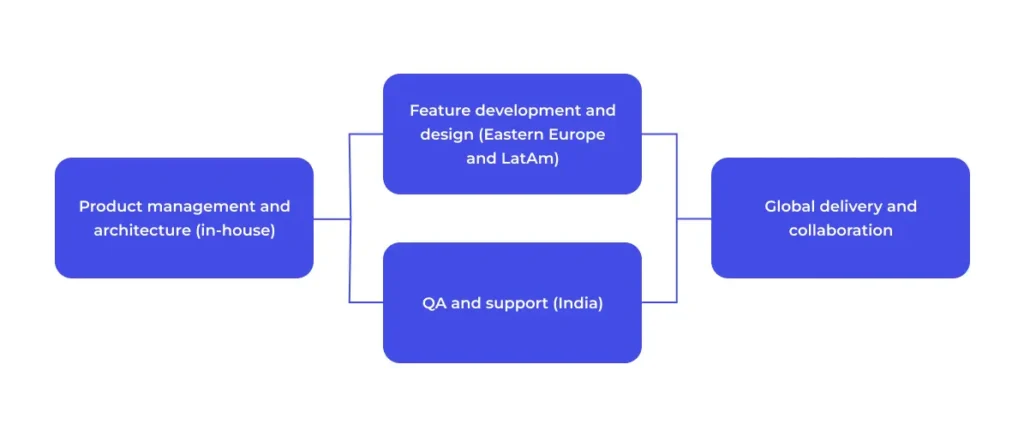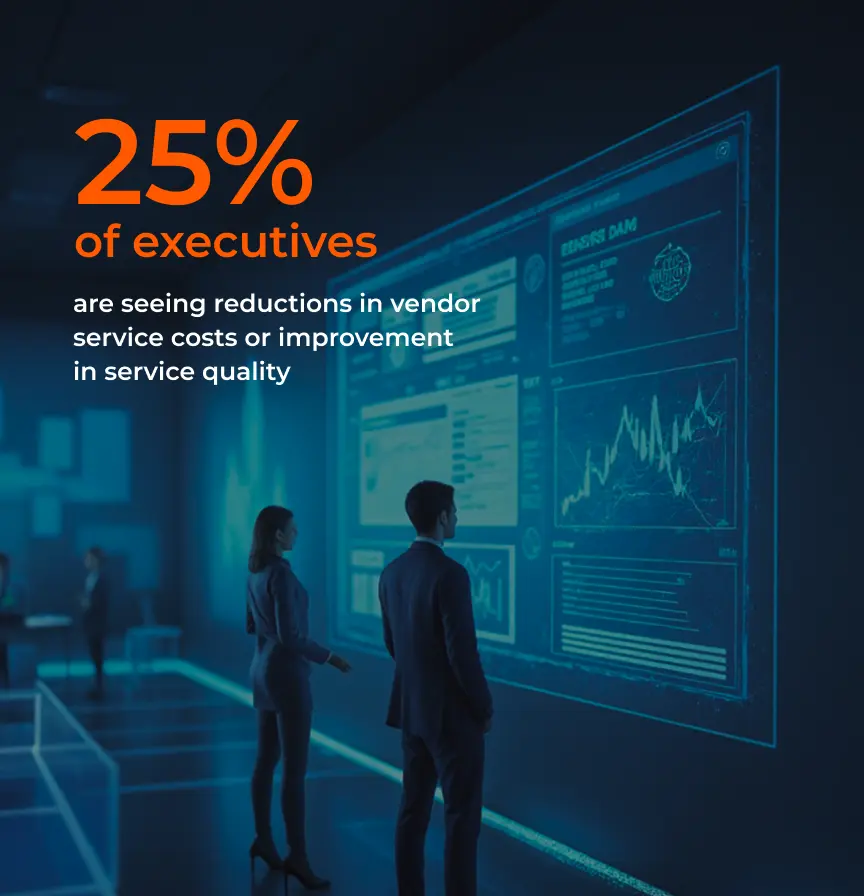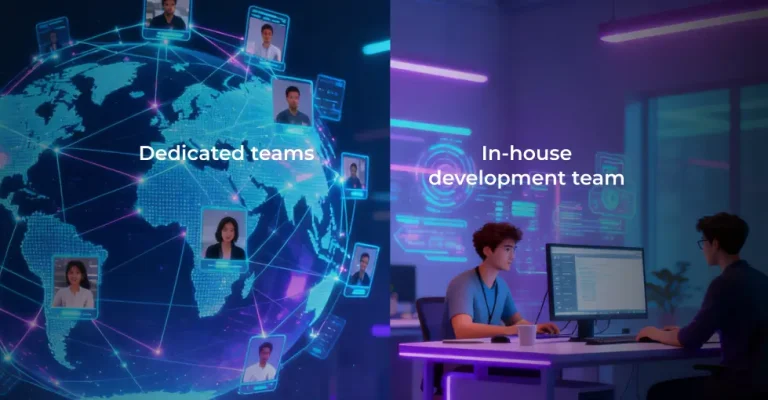Software engineering services are undergoing a significant transformation. With industry shifts driven by artificial intelligence, agentic automation, and cloud computing, companies are rethinking how they approach outsourcing — whether it’s nearshore, offshore, or onshore. Comparisons between these models now have to account for how AI is augmenting the design and development of digital products.
According to a recent Deloitte survey, 57% of companies are establishing new outsourcing relationships with a focus on AI. As intelligent tools reduce the importance of geographical proximity, companies are increasingly outsourcing higher-value activities to drive stronger ROI. With productivity gains of over 30% unlocked through AI augmentation, vendors can deliver greater value to clients, often within shorter timeframes. Still, to capture these advantages, companies must understand the unique benefits and trade-offs of each outsourcing model.

This article will zoom in on these benefits and trade-offs while also exploring hybrid outsourcing strategies that combine the strengths of multiple models. We’ll examine key decision-making factors and regional advantages, highlight common pitfalls (and how to avoid them), and look at emerging trends such as AI-driven automation and new outsourcing destinations that are reshaping global delivery strategies.
Whether you’re new to outsourcing or reevaluating your approach, this guide will help you select the ideal model for your business.
Defining onshore, nearshore, and offshore outsourcing
Before diving into benefits, trade-offs, and trends, it’s important to establish what each outsourcing model means in practice. While all three approaches involve leveraging external teams to build and maintain digital products, the geographical relationship between client and vendor creates very different dynamics.
What is onshore outsourcing?
Onshore outsourcing refers to contracting vendors located in the same country as the client. For example, a U.S. tech company might hire a development partner in lower-cost hubs such as North Carolina, Texas, or Florida, where average developer salaries can be more than 15% below the national average. This strategy can be particularly attractive for companies based in high-cost regions like California, where salaries exceed the national average by as much as 22%.
Onshore outsourcing ensures the closest cultural alignment, easy collaboration, and shared legal and regulatory frameworks. However, it is also the most expensive model overall compared to nearshore and offshore options, which is why many companies still look abroad for greater cost efficiency.
What is nearshore outsourcing?
Nearshore outsourcing is often associated with working with teams in neighboring regions — for U.S. companies, this typically means Latin America. However, for companies on the U.S. East Coast, nearshoring can also extend to Central and Eastern Europe.
Hubs in Poland, Slovakia, Bulgaria, or Romania allow for 4–5 hours of overlapping work time with cities like New York, which is often enough to support agile workflows and same-day communication. With proper project management and collaboration tools, these setups function effectively as nearshore partnerships rather than traditional offshore arrangements.
What is offshore outsourcing?
Offshore outsourcing is usually defined by large time zone gaps (for example, U.S. companies working with teams in India or Southeast Asia), and the definition can shift depending on geography. For businesses on the U.S. West Coast, even European destinations like Poland or Romania still qualify as offshore, since the overlap is minimal.
This means the same software dev regions can be considered nearshore for East Coast firms but offshore for West Coast ones. Recognizing this relativity helps companies set realistic expectations around communication patterns and collaboration speed.
Quick comparison of nearshore, offshore, and onshore models
| Factor | Offshore | Nearshore | Onshore |
| Cost Range | $25,000–$100,000 (MVP) Avg. $18–$50/hr | $50,000–$150,000 (MVP) Avg. $35–$70/hr | $100,000–$250,000 (MVP) Avg. $100–$250/hr Note: U.S. hubs vary: lower-cost states (TX, NC, FL) can be ~15% below national avg.; high-cost states (CA, NY) can be up to ~22% above |
| Time zone alignment | Typically 6–12 hrs difference; limited overlap | Usually 1–4 hrs difference; strong overlap in working hours | Same country/time zone |
| Cultural alignment | Moderate to low | Moderate to high | Very high |
| Talent access | Very broad (global pools) | Strong regional expertise | Deep but expensive |
| Compliance & IP | Varies by country; moderate to low | Generally strong; GDPR-aligned in many regions | Very strong — HIPAA, GDPR, SOC-2 |
| Best fit for | Cost-sensitive MVPs, modular tasks | Agile workflows, frequent collaboration | Data-sensitive, compliance-heavy projects |
Key factors in choosing outsourcing strategies and models
Cost reduction has historically been the primary driver behind outsourcing decisions. In fact, 70% of respondents to Deloitte’s 2020 outsourcing survey cited cost savings as their top motivation. While lowering budgets remains central, companies weigh other critical factors, such as time zone alignment, cultural and legal compatibility, talent availability, and the complexity of managing processes, quality control, and governance.
Cost & budget savings
- Onshore: Hiring locally is often significantly more expensive than nearshore or offshore options. Even when targeting cheaper domestic hubs, companies face hidden expenses such as overhead, employee benefits, and higher operating costs passed down by vendors that focus exclusively on onshore outsourcing.
- Nearshore: This model typically offers 30–50% savings compared to onshore, while still facilitating streamlined real-time collaboration due to closer time zones and cultural alignment. Rates are higher than offshore, but the balance of cost and communication efficiency makes it attractive for many companies.
- Offshore: Development hubs in Asia offer the deepest savings — sometimes 50–70% compared to onshore. However, these savings can be offset by challenges such as communication delays or added management overhead. This makes vendor selection and governance especially critical.
Time zone overlap & collaboration windows
- Onshore: Operating in the same time zone can be crucial for highly complex, fast-paced projects that require rapid decision-making and synchronous collaboration. This is especially true when requirements, priorities, and scope can change frequently and at later stages of the development cycle.
- Nearshore: With 4–8 overlapping working hours between in-house and remote teams, nearshore development can support rapid, agile projects. Companies often choose this model to extend in-house teams and drive higher efficiency across product and feature development efforts.
- Offshore: Significant time zone differences leave little to no opportunities for synchronous collaboration. Conversely, these gaps enable continuous operations in a “follow-the-sun” (FTS) model. For instance, QA engineers in India can test code developed in the U.S. or LATAM overnight, reducing cycle times.
Business culture and legal alignment
- Onshore: Shared legal frameworks and regulatory standards are beneficial for industries with strict compliance needs (e.g., finance, healthcare, defense). Full alignment on regulatory frameworks is also critical for unique intellectual property (IP), such as patent-pending products, and software that handles sensitive data.
- Nearshore: Companies working with talent in nearshore regions such as Eastern Europe or Latin America can benefit from similarities in business culture and strong English proficiency. Vendors in these regions also operate under regulatory frameworks that make sensitive projects feasible (e.g., ISO, SOC 2, GDPR compliance, HIPAA in healthcare).
- Offshore: While differences in business culture and legal frameworks can be significant, leading vendors in India, the Philippines, and other hubs invest heavily in international compliance certifications. With proper due diligence, even sensitive projects can be delivered successfully offshore.
Talent availability
- Onshore: Limited to domestic talent pools that are often overfished in major hubs, onshoring can be suboptimal for high-demand specializations. Still, established onshore vendors are able to source exceptional talent across all tech stacks and seniority levels much faster than traditional hiring models.
- Nearshore: By tapping into the talent pools across two continents, nearshoring grants tech companies access to hundreds of millions of highly skilled experts. And it’s not just about quantity: Eastern Europe is renowned for its exceptional STEM education, while Latin America has strong government-backed training initiatives, such as Argentina’s Programa 4.0.
- Offshore: Asia is home to some of the largest talent pools globally, with India alone boasting more software professionals than the U.S. While scale is a clear advantage, large talent pools are notoriously more challenging to navigate. As a result, companies must carefully vet the expertise and quality of vendors to ensure alignment with project needs.
Quality control & project management complexity
- Onshore: Typically the simplest model to manage, onshoring is characterised by minimal barriers in communication, culture, or legal compliance. Project management is straightforward, and QC processes can align directly with internal workflows.
- Nearshore: Shared working hours and cultural similarity ease project oversight, but distributed teams still require structured communication protocols. With experienced vendors, quality can be as high as onshore, especially when agile ceremonies are aligned.
- Offshore: The most challenging to manage due to distance, culture, and time zone separation. QC risks include inconsistent standards, delayed feedback loops, and rework. However, with rigorous governance, strong vendor selection, and clearly defined escalation paths, offshore teams can deliver high quality at scale. The key lies in investing upfront in processes and tools that bridge the distance.
Common challenges across models (and how to solve them)
Outsourcing brings efficiency, cost savings, and access to global expertise, but it also introduces challenges that are inherent to various models. Many of these challenges don’t stem from geography alone but from how teams collaborate, how processes are managed, and how prepared the client company is for distributed delivery.
Communication breakdowns
Even in-house teams can struggle with unclear requirements, while remote collaboration introduces additional complexity in the form of asynchronous communication and project management. Misaligned expectations often result in misinterpreted deliverables, delays, or rework.
How to solve it: Conduct thorough discovery sessions, establish clear documentation standards and structured communication protocols, and create overlapping collaboration windows wherever possible. Using asynchronous tools like Slack, Notion, or Jira can also help bridge time zone gaps.
Quality & delivery risks
When managed poorly, distributed delivery can result in inconsistent quality standards, missed deadlines, or deviations from the agreed-upon scope. These risks are more pronounced when vendor oversight is weak or when the client organization lacks clear escalation paths.
How to solve it: Implement robust quality assurance processes from day one. This includes automated testing, peer code reviews, and milestone-based progress tracking. Partnering with vendors experienced in agile practices can reduce risk further by ensuring continuous alignment.
Hidden costs & budget overruns
Cost savings are often the headline benefit of outsourcing, yet projects sometimes face budget creep. Hidden costs can include travel expenses, legal fees, management overhead, or rework when quality is not managed correctly.
How to solve it: Build a realistic total cost of ownership (TCO) model at the outset. This should include governance, compliance, and integration expenses—not just hourly developer rates. Frequent financial reviews help identify and correct issues early.
Security & compliance concerns
Whenever sensitive data, intellectual property, or regulated industries are involved, security and compliance risks escalate. These risks can be present in any outsourcing model if safeguards are not in place.
How to solve it: Work only with vendors that hold relevant certifications. Implement strict access controls, NDAs, and data encryption. Shared responsibility models where both client and vendor own parts of compliance reduce exposure.
Company readiness for outsourcing
Perhaps the most underestimated challenge is the client organization’s own maturity. Teams without prior experience in distributed collaboration often underestimate the level of preparation required. Stakeholder misalignment, lack of clear KPIs, or insufficient internal processes can derail even the best vendor relationship.
How to solve it: Before outsourcing, assess internal readiness. Do you have well-documented processes? Is there executive sponsorship for distributed work? Have roles and responsibilities for vendor management been clearly defined? Treat outsourcing as a strategic shift, not just a staffing decision.
Bringing it all together
None of these challenges is a deal-breaker. In fact, they are common across onshore, nearshore, offshore, and even in-house development models. The key lies in proactive management: setting expectations early, establishing strong communication protocols, enforcing quality standards, and ensuring internal readiness. Companies that invest upfront in governance consistently report higher satisfaction with outsourcing outcomes.
Hybrid and evolving models
Modern outsourcing strategies increasingly favor hybrid approaches, blending onshore, nearshore, and offshore resources to optimize both cost and collaboration. Hybrid models allow companies to allocate different parts of the product lifecycle to the most suitable locations. Under such models, high-value, compliance-sensitive tasks might remain onshore, while nearshore or offshore teams handle agile development and QA.
For example, when partnering with AgileEngine, tech companies often choose to retain product management and architecture roles locally while leveraging our Eastern European and LATAM developers for feature development and design, and offshore teams in India for QA and support. This setup strikes a balance between cost savings and access to global talent pools, reduces dependency on a single region, and enables around-the-clock delivery through follow-the-sun workflows.

The benefits of hybrid models go beyond financial efficiency. Companies gain flexibility to scale resources quickly, tap into specialized skill sets across geographies, and mitigate geopolitical or economic risks. Additionally, hybrid teams can combine the cultural alignment and regulatory familiarity of nearshore or onshore teams with the cost advantages of offshore providers, creating a resilient delivery framework.
Ultimately, hybrid outsourcing reflects the evolving nature of global tech delivery. It leverages the strengths of each model while minimizing weaknesses, enabling companies to remain competitive, agile, and resilient in a rapidly changing technological landscape.
Vendor selection and governance best practices
Choosing the right outsourcing partner goes far beyond hourly rates or immediate availability. Strategic vendor selection and strong governance frameworks are essential to ensure successful delivery, consistent quality, and long-term value.
Due diligence checklist
Before signing any agreement, companies should conduct thorough vetting. Key considerations include:
- Compliance and certifications: Verify that the vendor holds industry-relevant standards (e.g., ISO, SOC 2, HIPAA, GDPR) to reduce security and regulatory risks.
- References and case studies: Assess past performance on similar projects, focusing on delivery quality, process maturity, and collaboration effectiveness.
- Financial stability: Ensure the vendor has a solid operational and economic history, including consistent revenue growth, a reliable client base, and the ability to sustain long-term projects without risk of service disruption.
- Cultural and language fit: Evaluate communication practices, English proficiency, and cultural compatibility, particularly for nearshore and offshore models.
Engagement models
Selecting the right engagement structure aligns the vendor’s incentives with your business strategy and project goals:
- Staff augmentation: ideal for scaling internal teams with external talent while retaining full management control.
- Dedicated teams: vendors provide a full team working exclusively on the client’s project, reducing onboarding overhead.
- Managed services: the vendor assumes responsibility for end-to-end delivery, often including governance, QA, and operations.
Governance frameworks
Effective governance mitigates risk and ensures alignment:
- KPIs and metrics: Define clear metrics for quality, productivity, and delivery timelines to ensure effective performance. Examples include code quality, defect rates, sprint velocity, and deployment frequency.
- SLAs and contracts: Specify service expectations, penalties, and escalation procedures to maintain accountability.
- Agile cadences: Regular ceremonies, such as stand-ups, sprint reviews, and retrospectives, maintain transparency, foster collaboration, and accelerate problem-solving.
- Communication protocols: Establish structured reporting channels, update frequencies, and escalation paths for timely issue resolution.
Building long-term partnerships
Outsourcing relationships thrive when treated as strategic partnerships, rather than short-term transactions. Encouraging knowledge sharing, aligning on business objectives, and investing in team integration strengthen trust and drive sustainable outcomes. Companies that cultivate long-term vendor relationships often see improved innovation, efficiency, and responsiveness to evolving business needs.
Future trends in outsourcing
The outsourcing landscape is evolving rapidly, influenced by technological, economic, and geopolitical forces. Tech companies must stay ahead of these trends to maximize efficiency, innovation, and resilience in their delivery strategies.
Emerging destinations and market competition
Traditional outsourcing hubs such as India, Poland, and Mexico continue to attract demand, but competition is intensifying. Driven by rising costs in established destinations and the search for untapped talent pools, companies are expanding into new markets in Guatemala, Romania, Bulgaria, Slovakia, and even Western European countries such as Portugal and Spain. These emerging regions offer opportunities for effective, high-quality delivery while diversifying geopolitical and economic risk.
Automation and AI in outsourcing
Artificial intelligence and automation are reshaping what it means to outsource. AI-powered tools support project management, code generation, testing automation, and communication, reducing the dependence on geographical proximity. For example, predictive analytics can optimize task assignment across distributed teams, while AI-based translation and documentation tools help bridge language gaps.

As a result, companies can outsource increasingly complex work to remote teams with minimal friction. In fact, 25% of executives report seeing improvements in outsourcing value thanks to AI augmentation, highlighting its growing impact on outsourcing efficiency and ROI.
Shifting focus to high-value roles
Outsourcing is evolving beyond routine development tasks to higher-value activities, including solution architecture, UX research, vCISO services, and cloud-native design. Vendors capable of delivering these roles bring strategic expertise that accelerates innovation and improves business outcomes. Companies increasingly seek partners who can provide flexible access to senior talent across multiple disciplines.
Distributed innovation models
Global delivery models enable around-the-clock development through follow-the-sun workflows. By distributing work across regions, companies reduce cycle times, accelerate feature releases, and ensure continuous monitoring and support. This approach also fosters distributed innovation, as diverse teams contribute unique perspectives to problem-solving and product design.
Impact of macroeconomic and geopolitical factors
Currency volatility, regulatory changes, political stability, and trade policies influence outsourcing decisions more than ever. Companies that monitor these factors and build flexible, multi-region delivery networks can mitigate risk and respond quickly to shifting global conditions.
The strategic imperative
Ultimately, future-proof outsourcing requires the right blend of technology, process, and talent strategy. Firms that embrace AI, leverage hybrid delivery models, and maintain robust governance are better positioned to deliver quality, scale, and innovation — regardless of geography.
Choosing the right model is all about informed decision-making and strategic planning
Outsourcing models are not one-size-fits-all. Each approach offers unique advantages depending on budget, talent needs, collaboration style, and regulatory requirements. Success depends less on geography and more on strategic alignment, internal readiness, and robust governance practices.
Hybrid models are increasingly becoming the preferred strategy, allowing companies to balance cost efficiency with access to specialized talent and seamless collaboration. Leveraging AI and automation further enhances productivity, quality, and speed, enabling distributed teams to deliver high-value outcomes across time zones.
For tech companies seeking growth and resilience, the key takeaway is clear: evaluate outsourcing partners not only for cost savings but for flexibility, expertise, and the ability to scale across nearshore and offshore locations.
To explore how AgileEngine can support your business, consider our end-to-end outsourcing services across 15 countries in the Americas, Europe, and Asia. Our expertise spans software development and design, QA/AQA, data engineering, and AI solutions, enabling companies to build hybrid teams that help them innovate faster, with maximum efficiency and impact.
FAQ
What is the difference between onshore, nearshore, and offshore outsourcing?
Onshore outsourcing involves hiring vendors within the same country, nearshore refers to nearby countries with similar time zones, and offshore typically means working with teams in distant regions. Each model varies in terms of cost, talent access, ease of collaboration, and regulatory alignment.
How do I decide which outsourcing model is right for my company?
Consider factors such as budget, talent requirements, time zone alignment, cultural fit, and project complexity when evaluating potential candidates. Hybrid models that combine onshore, nearshore, and offshore resources often provide the best balance of cost, quality, and flexibility.
Where can I find a reliable outsourcing location comparison for tech services?
A reliable outsourcing location comparison evaluates cost, talent availability, time zone overlap, cultural alignment, and regulatory frameworks. AgileEngine provides insights across 15 countries in the Americas, Europe, and Asia, helping companies select the optimal mix of delivery options for their specific needs.
What are the key trends shaping outsourcing in 2025 and beyond?
AI and automation, hybrid team models, follow-the-sun workflows, and the emergence of new delivery destinations are reshaping outsourcing. Companies that integrate these trends can achieve faster development cycles, improved quality, and greater access to specialized talent.













